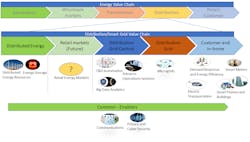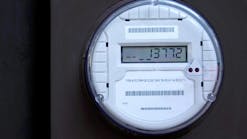If you ask four people to define what a smart grid is, you will get five answers. The smart grid is not simply about implementing technology. It is really a complete business transformation for electric utilities challenging the status quo and requiring changes to people and processes [1]. If these changes are considered in totality, the implementation will be successful. If not, the benefits will be lower than expected.
Intelligence in the grid is generally associated with the ability to:
- Sense and understand the state of the network,
- Control devices in the field to alter the state of the network if necessary, and
- Use decision-support tools allowing the sensed information to be converted into controls.
There was no single, pivotal event that triggered the onset of the smart grid. Rather, it was a series of somewhat disconnected events and expectations that led to this revolution.
- Modern customer expectations: Customers who are more used to the iPhone era are expecting their utilities to provide quick feedback on status of outages, more choice on power use, and the ability to interact via smartphone apps.
- Modern customer actions: Electric utility customers are also enacting changes impacting the grid. They are installing wind farms, solar photovoltaics (PVs), buying electric cars, changing the delivery landscape, and the traditional utility/customer relationship.
- More affordable information technologies: For newer information technology (IT) that is smaller and consumes less power, it follows it should be more affordable. Sensors and controls are being designed that — thanks to cheaper access to ubiquitous communications — allow the utility operator to better control the flow of power at a lower cost of installation.
- IT and architecture advances: Cloud computing, mobile computing, machine learning, big data analytics, and artificial intelligence (AI) are enabling companies to implement advanced solutions more easily and at a lower cost.
- More options for solving the same problem: Newer operations technology (OT) alternatives under a broad grouping called distributed energy resources (DERs) are providing increased possibilities for generation, transmission, and consumption of power.
Much progress is being made is all the areas. Newer technologies are being developed, costs are falling, and more capabilities are available. These are all leading to more opportunities to support increased sensing, controls, and intelligence in the network. This perfect storm, being influenced by the changes identified above, is called, the "smart grid" and it is altering the entire utility power system landscape.
Defining the Smart Grid
The smart grid can be defined as a modernized electrical grid, a reliable and secure transmission and distribution (T&D) infrastructure that can meet demand growth in the future, while intelligently responding to the behavior and actions of all electric power users connected to it — delivering power in a reliable, efficient, economic, and sustainable manner [2].
The greater focus of the smart grid is on distribution. The transmission system already has extensive sensing and control which is increasing with newer technologies such as synchrophasors, associated controls, and decision-support systems. The long overdue emphasis on distribution is because of several factors, such as:
- Increasing customer expectations for greater reliability;
- Increasing complexity in types of consumption devices being added to the grid, such as newer televisions, smartphone and electric vehicle (EV) charging, and EVs leading to an increasing need for better power quality;
- Increasing need to reduce the dependence on fossil fuels and reduce greenhouse gas (GHG) emissions resulting in increasing penetration of distributed renewables;
- An increasing need to reduce costs to the customer; and
- Several others [3].
The key attributes of a modern grid are:
- Is intelligent in sensing system overloads and taking corrective action.
- Can accommodate renewables and distributed energy.
- Is sustainable by reducing dependence on fossil fuels and decreasing carbon emissions.
- Is resilient to natural disasters and attacks.
- Is efficient in meeting increased consumer demand without adding infrastructure.
- Provides a safe environment for utility workforce and consumers.
- Can deliver the power quality needed for a digital economy.
Ongoing Challenges and the Future
Making the smart grid a reality is not easy. Grid modifications are expensive and difficult. Investments need to be considered based on their business benefits. In addition, innovation is happening at many levels in every dimension such that an implementation performed today may become obsolete within a few years. Some examples of innovation causing challenges are provided below:
- Residential meters: Just in the last 10+ years, technology has moved from electromechanical meters to automated meter reading (AMR) to advanced metering infrastructure (AMI). Smart meters and technologies include mechanisms capable of sensing energy, voltage, power quality, and other quantities. Additionally, they perform control actions such as remote connect/disconnect. AMI meters are allowing utilities to perform actions at a level unforeseen in the past — so much so that utilities have not even scratched the surface in terms of the what they can do with the data [4].
- Telecommunications: The smart grid is heavily dependent on a ubiquitous telecom network. The network is necessary to take data from where it is created to where it is needed and processed. It is also necessary to allow the various control actions both at the residence and at the grid.
- Automation (sensing and control): There is a significant dependence upon sensors providing information on the state of the grid and the ability to react to adverse conditions by changing that state through the use of controls. Utilities should be careful in spending on automation. In all practicality, solving priority problems capable of delivering the most benefit makes more sense than taking on a system-wide project.
- Demand response (DR) versus energy storage: The advent of American Recovery and Reinvestment Act of 2009 (ARRA) [5] efforts in the United States led to the identification of DR as low hanging fruit for smart grid implementations focused on peak shaving. The initiation of electric energy storage has created a new opportunity to store energy when it is cheap and discharge it when energy is expensive. Storage also can be sited in places and activated with no customer involvement or action — something DR cannot claim. As utilities consider implementing DR across their territories, they also need to consider the potential for storage options that can deliver the same outcomes.
- Privacy: The inception of smart meters (AMI) has allowed utilities access to large amounts of customer-specific data. This data represents an unprecedented level of access to customer energy consumption which in turn leads to an unparalleled level of access into customer behavior inside the home. Analyzing this data with the right set of analytic mechanisms can allow a person or a company with questionable intentions to (1) understand the energy consumption habits (and cycles) of people living in the house (2) deduce whether they are in the house or not (3) deduce whether they are on vacation or not (4) get enough insights to determine whether they are a candidate for a targeted marketing campaign for some products.
- Cybersecurity: The multitude of sensors in the field, such as, smart meters, distribution automation, and others have resulted in a large number of devices connected to the power grid across communication networks running on industry-standard networks. The move to greater number of end points and the use of industry-standard communication mechanisms are immediately resulting in many points in a network that can now be hacked.
It is important to note while the challenges of the smart grid are many, the benefits are even more. The smart grid has delivered an electric utility future which involves:
- Distributed and centralized renewables playing a significant part leading to reduced GHG emissions,
- A more reliable grid with fewer outages,
- More choice for the customer in terms of service providers, all with the increased potential for lower costs of electricity at home/premises [6, 7].
Conclusion
In a modern grid, everything will change over time. The grid will look different and even work differently [8]. Some of the major changes we can expect in the future will include:
- The entity known today as the consumer (or customer) will both consume and generate power (become a prosumer) by installing one or more DERs within their premises.
- The utility of today could morph into becoming the wires provider for transmission and/or distribution.
- Service providers such as telecom, security systems, internet service, or others could take on the role of providing electricity as a service and bundle it along with the other services being provided by them.
- Microgrids could form and depending on their business need, could partially or completely separate themselves from the utility grid.
The journey to a modern grid is one of continually improving the operations of the grid through increasing levels of intelligence and the ability to use this intelligence to improve the operational efficiencies of the grid and offer better service to the customer. This requires the front-office, back-office, and mid-office systems to be all integrated and most importantly related to the customer. Much of the fundamentals come from automation and supported business architecture being defined here and need to be in place in advance to deliver on the customer mandate. If the architecture is not in place, the utility will need to implement them on a piecemeal basis leading to increased cost to the customer and inefficient operations at the utility.
It is important to note the expectations of the typical customer in other industries are much higher than they expect from a utility. However, it is believed the electric utility will also get there in time. This means that in the next 10 years, utilities need to get their automation (and other) systems in place to deliver on this expectation. In addition, as New York (REV) and California (Better than Smart) initiatives go operational, other states will start looking at their initiatives and push their utilities to move forward in the same direction.
This is transformation — the entire utility needs to change for the conversion to be real.
This transformation will affect system (T&D) operations, outage management, customer service, and asset management, all the way to corporate investment and planning.
References
[1] Vadari, M., Carvallo, A., Marsh, W., et. al., ‘Disruption becomes evolution: creating the value-based utility,’ Whitepaper published by CMG. Available at http://www.512cmg.com/services/white-papers/
[2] Andres Carvallo and John Cooper, ‘The Advanced Smart Grid, 2nd Edition,’ 2015
[3] Vadari, M.: ‘Active demand management — a system approach to managing customer demand,’ Public utilities fortnightly, November 2009
[4] Green Tech Media Staff, “Data Analytics and Smart Grid: The Rising Tide for Power Utilities,” https://www.greentechmedia.com/articles/read/data-analytics-and-smart-grid
[5] GRID4EU: ‘GRID4EU’ (August 2015) Retrieved from grid4eu.eu: http://grid4eu.eu/overview.aspx
[6] 1108r3, N. S.: ‘NIST framework and roadmap for smart grid interoperability standards, release 3.0.’ (September 2014). Retrieved from nist.gov: https://www.nist.gov/sites/default/files/documents/smartgrid/NIST-SP-1108r3.pdf
[7] DOE, U.: ‘2014 smart grid system report’ (August 2014). Retrieved from energy.gov: https://www.energy.gov/sites/prod/files/2014/08/f18/SmartGrid-SystemReport2014.pdf
[8] Smart Grid Information Clearinghouse: (2013). Retrieved from sgiclearinghouse.org: http://www.sgiclearinghouse.org/Technologies



